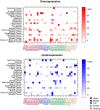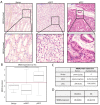Comprehensive analysis of the transcriptional profile of the Mediator complex across human cancer types
- PMID: 27050271
- PMCID: PMC5029609
- DOI: 10.18632/oncotarget.8469
Comprehensive analysis of the transcriptional profile of the Mediator complex across human cancer types
Abstract
The Mediator complex is a key regulator of gene transcription and several studies demonstrated altered expressions of particular subunits in diverse human diseases, especially cancer. However a systematic study deciphering the transcriptional expression of the Mediator across different cancer entities is still lacking.We therefore performed a comprehensive in silico cancer vs. benign analysis of the Mediator complex subunits (MEDs) for 20 tumor entities using Oncomine datasets. The transcriptional expression profiles across almost all cancer entities showed differentially expressed MEDs as compared to benign tissue. Differential expression of MED8 in renal cell carcinoma (RCC) and MED12 in lung cancer (LCa) were validated and further investigated by immunohistochemical staining on tissue microarrays containing large numbers of specimen. MED8 in clear cell RCC (ccRCC) associated with shorter survival and advanced TNM stage and showed higher expression in metastatic than primary tumors. In vitro, siRNA mediated MED8 knockdown significantly impaired proliferation and motility in ccRCC cell lines, hinting at a role for MED8 to serve as a novel therapeutic target in ccRCC. Taken together, our Mediator complex transcriptome proved to be a valid tool for identifying cancer-related shifts in Mediator complex composition, revealing that MEDs do exhibit cancer specific transcriptional expression profiles.
Keywords: MED8; Mediator complex; Pathology Section; cancer; oncomine; transcriptional profile.
Conflict of interest statement
We declare no conflict of interest.
Figures




References
-
- Flanagan PM, Kelleher RJ, 3rd, Sayre MH, Tschochner H, Kornberg RD. A mediator required for activation of RNA polymerase II transcription in vitro. Nature. 1991;350:436–438. - PubMed
-
- Carlson M. Genetics of transcriptional regulation in yeast: connections to the RNA polymerase II CTD. Annu Rev Cell Dev Biol. 1997;13:1–23. - PubMed
-
- Daniels DL, Ford M, Schwinn MK, Benink H, Galbraith MD, Amunugama R, Jones R, Allen D, Okazaki N, Yamakawa H, Miki F, Nagase T, Espinosa JM, et al. Mutual Exclusivity of MED12/MED12L, MED13/13L, and CDK8/19 Paralogs Revealed within the CDK-Mediator Kinase Module. J Proteomics Bioinform. 2013;S2(004):1–7.
MeSH terms
Substances
LinkOut - more resources
Full Text Sources
Other Literature Sources
Research Materials

